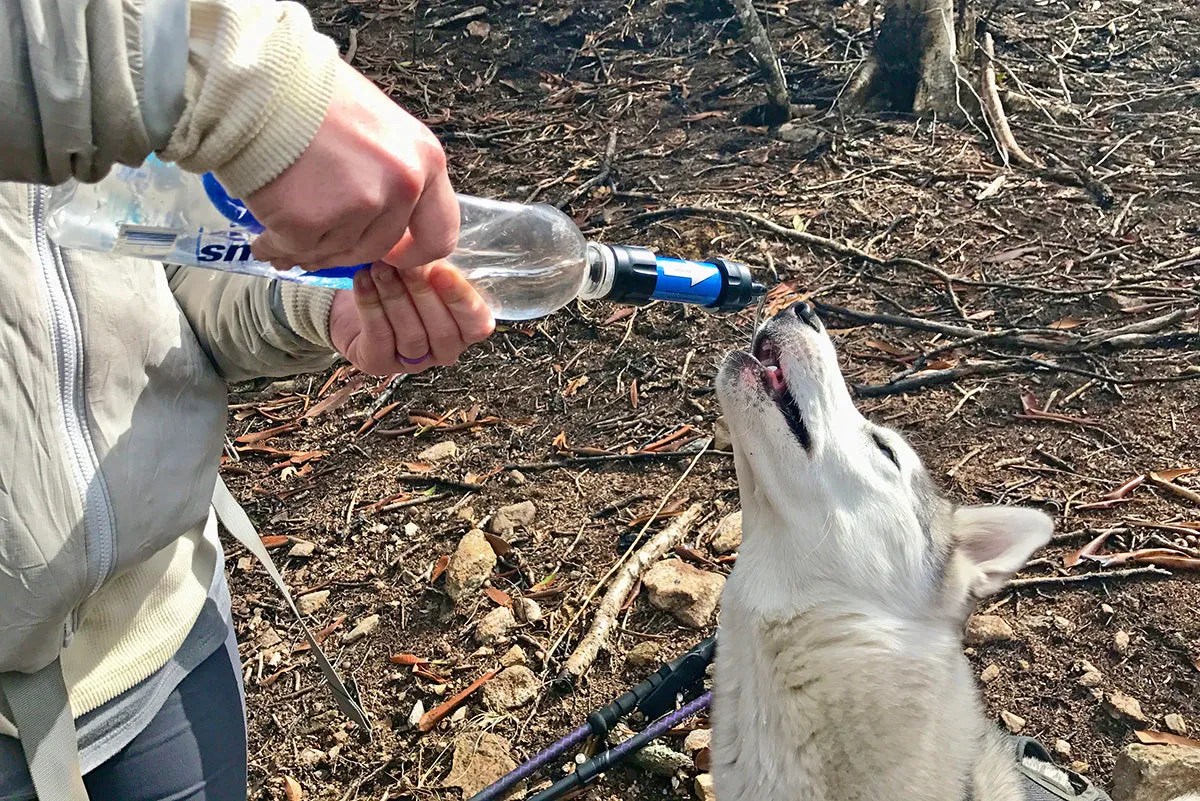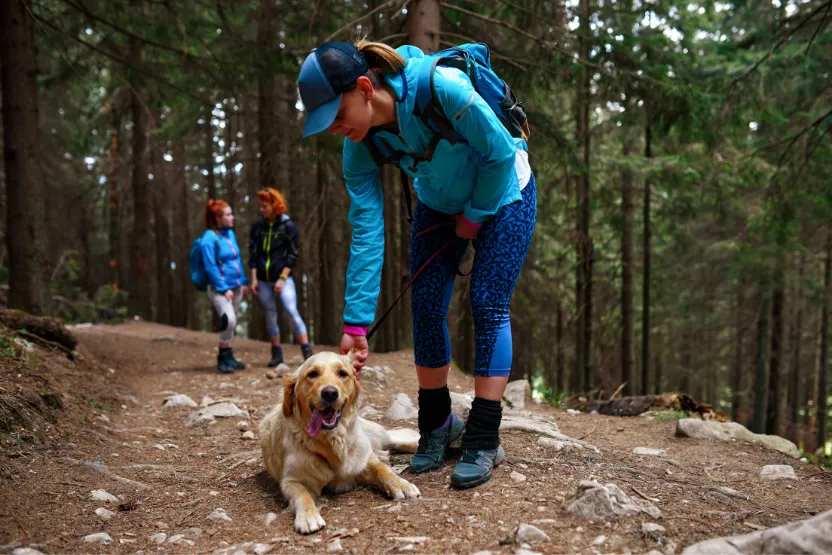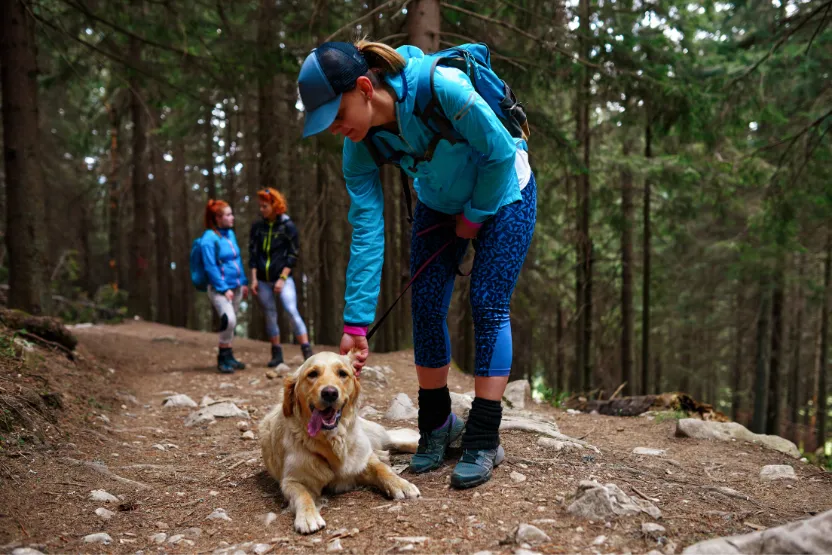Every tail-wagging adventure starts with a safe plan. At National Park Shops, we know that hiking with pets isn't just about the destination, it’s about keeping your furry companion safe and happy every step of the way. That’s why we’ve compiled these essential hiking with pets safety tips to help you prepare smartly, protect confidently, and enjoy nature together without worry. From hydration hacks to navigating tricky trails, this guide ensures you and your pet are adventure-ready for any terrain.
Bring Enough Water for Your Dog
Ensuring your pet stays hydrated is one of the most critical hiking with pets safety tips. Just as humans need consistent water intake during outdoor activities, so do dogs. Dehydration can occur rapidly, especially in hot weather or during strenuous hikes. Always carry ample water specifically for your dog, in addition to your own supply, and bring a collapsible water bowl to make drinking easier on the trail.
A good rule of thumb is to offer your dog water every 15-30 minutes, depending on the temperature and trail difficulty. Never assume that natural water sources will be safe for your pet to drink from, as they may contain harmful bacteria or parasites. Carrying enough water for both of you ensures that your pet stays refreshed and avoids dangerous conditions like heat exhaustion. Among all hiking with pets safety tips, proactive hydration is fundamental to a successful adventure.
>> You may be interested in related topics: Best Dog Sunscreens

Check for Dog-Friendly Trails
Before heading out, one of the essential hiking with pets safety tips is to research whether the trail is dog-friendly. Not all parks and trail systems allow pets, and some may have specific leash laws or restrictions. Visiting official park websites, reading recent trail reviews, or calling park offices can provide up-to-date information regarding pet policies.
Choosing trails that accommodate pets ensures a more relaxed and enjoyable experience for both you and your furry companion. Dog-friendly trails often provide amenities like waste disposal stations, water fountains, or shaded rest areas. Additionally, these trails are typically safer, as they’re designed with pet considerations in mind. Confirming trail policies in advance is a crucial step in any responsible pet-friendly hiking plan.
Pack a First-Aid Kit
Having a well-stocked first-aid kit is a top priority in all hiking with pets safety tips. Accidents can happen, from minor paw injuries to insect bites or allergic reactions. Your kit should include pet-specific items such as antiseptic wipes, paw balm, tweezers for tick removal, and vet wrap. Don’t forget to pack your dog’s medications if they have any ongoing health concerns.
It’s also wise to include a compact guidebook on pet first-aid procedures, ensuring you’re prepared to respond to injuries promptly. Familiarize yourself with basic first-aid techniques, like how to treat cuts or wrap a sprained limb. Being proactive with a first-aid kit not only protects your pet’s well-being but also gives you peace of mind during your adventure. Safety and preparation go hand in hand when hiking with pets.
Avoid Heat Stroke
One of the most dangerous threats during a hike is heat stroke, making prevention a key aspect of hiking with pets safety tips. Dogs can overheat quickly, especially breeds with thick coats or brachycephalic (short-nosed) breeds. Watch for early warning signs such as excessive panting, drooling, lethargy, or bright red gums.
To prevent heat stroke, schedule hikes during the cooler parts of the day, like early morning or late afternoon. Always provide ample shade and water, and take frequent breaks to let your dog rest and cool down. Never push your pet beyond their comfort zone. Being vigilant about heat exposure and recognizing early symptoms can save your pet’s life. Heat management is non-negotiable when considering hiking with pets safety tips.

Wildlife Dangers for Dogs
While exploring nature, it’s important to consider wildlife encounters as part of your hiking with pets safety tips checklist. Dogs are naturally curious and may not recognize the dangers posed by wild animals. Encounters with snakes, bears, coyotes, or even porcupines can result in serious injuries or worse.
Always keep your dog on a leash to prevent them from wandering off the trail. Stay alert for wildlife signs such as tracks, scat, or rustling in bushes. Carrying bear spray or noise-making devices can deter larger animals. Education on local wildlife and their behaviors will help you avoid potentially dangerous encounters. Awareness and prevention are key to ensuring a safe hike for both you and your pet.
>> Read More: Snake Bite Hiking First Aid: A Comprehensive Guide
Know Your Pet’s Limits
Understanding your dog’s physical limits is one of the most compassionate hiking with pets safety tips. Factors such as age, breed, fitness level, and health conditions all influence how far and how hard your pet can hike. Overexertion can lead to injuries, heat exhaustion, or severe fatigue.
Start with shorter hikes and gradually increase distance and difficulty as your dog builds endurance. Observe your pet for signs of discomfort, such as lagging behind, limping, or excessive panting. Regular vet check-ups ensure your dog is fit for the type of hikes you plan. Prioritizing your pet’s limits prevents overexertion and makes each hike enjoyable and safe.
Take Frequent Breaks
Taking regular rest breaks is a practical and effective hiking with pets safety tip that prevents overexertion. Breaks give your dog time to cool down, drink water, and recover energy. Find shaded spots along the trail for these rest periods, as direct sun can quickly lead to overheating.
Use break times to check your dog’s paws for cuts, debris, or signs of irritation. Offer treats to maintain their energy levels and morale. Frequent breaks not only enhance safety but also make the hike more enjoyable for your furry companion. Scheduling rest stops into your hike plan is a proactive approach to pet safety.
>> Read More: How To Hike With Your Dog: Essential Safety Tips

Use Proper Gear
Outfitting your dog with the right gear is essential in the hiking with pets safety tips arsenal. Invest in a sturdy, comfortable harness that provides better control and reduces strain on your dog’s neck compared to traditional collars. Leashes with hands-free options or shock absorption features can enhance comfort for both of you.
Consider protective booties if the trail is rocky, sandy, or has sharp terrain that could injure your pet’s paws. A well-fitted backpack allows your dog to carry their own water or treats, but ensure it’s not too heavy (no more than 10-15% of their body weight). Reflective vests or LED lights improve visibility, especially in low-light conditions. Proper gear maximizes safety, comfort, and convenience during your hike.
Monitor the Weather
Weather conditions can change rapidly, making it essential to include monitoring forecasts in your hiking with pets safety tips. Extreme temperatures, storms, or unexpected weather patterns can pose serious risks to your pet’s health. Before setting out, check multiple weather sources for up-to-date information.
Be prepared to adjust your hiking plans if conditions become unfavorable. Bring weather-appropriate gear like rain jackets or cooling vests, depending on the forecast. Avoid trails that become dangerous or impassable in wet conditions. Staying weather-aware ensures that your pet remains safe and comfortable throughout the hike.
>> Read More: The 9 Best Dog Winter Coats: Full-body and Waterproof
Be Aware of Allergens
Allergies can affect pets just as much as humans, making allergen awareness an important part of hiking with pets safety tips. Pollen, insect bites, or certain plants can trigger allergic reactions in dogs. Symptoms may include itching, swelling, sneezing, or skin irritations.
Before hiking, consult with your vet if your pet has known allergies and carry antihistamines if recommended. Wipe down your dog’s paws and coat after the hike to remove pollen or irritants. Familiarizing yourself with common regional allergens helps you take proactive steps to protect your pet. Awareness and prevention minimize the impact of allergens on your hiking adventure.
Don’t Allow Your Pet to Drink from Stagnant Water
While your dog may be tempted to lap up water from ponds or puddles, one of the top hiking with pets safety tips is to prevent them from drinking stagnant water. Such water sources often harbor harmful bacteria, parasites like Giardia, or toxic algae that can make your pet seriously ill.
Always provide clean, fresh water during breaks to keep your dog hydrated. Carrying a portable water filter or purifier can be a smart backup in emergencies. Educating yourself about the risks of natural water sources keeps your pet safe from preventable illnesses. Vigilance around water consumption is crucial for a healthy and incident-free hike.

Be Cautious with New Terrain
Introducing your pet to unfamiliar terrains requires extra attention as part of hiking with pets safety tips. Rocky paths, steep inclines, or dense underbrush can challenge your dog’s agility and balance. Proceed slowly and observe how your pet reacts to these conditions.
Train your dog on easier trails before attempting complex routes. Watch for signs of discomfort or hesitation, and never force your dog to navigate terrain that appears dangerous. Having a firm grip on the leash and providing verbal encouragement can help your pet adapt gradually. Being cautious with new terrain minimizes risks and builds your dog’s confidence over time.
Conclusion
Hiking with pets can be one of the most rewarding outdoor experiences, but it requires thoughtful planning and proactive safety measures. By consistently applying these hiking with pets safety tips, you ensure that every adventure remains enjoyable, safe, and stress-free for both you and your furry companion. From hydration and first-aid readiness to gear selection and environmental awareness, each precaution plays a vital role.
Empowering yourself with knowledge and preparation transforms potential hazards into manageable situations. Whether you’re a seasoned hiker or new to pet-friendly trails, these hiking with pets safety tips provide a reliable foundation for outdoor success. Prioritize your pet’s well-being, embrace the journey, and create unforgettable memories with your adventure partner by your side.
>> Read More:

